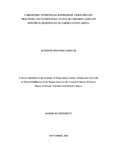CAREGIVERS’ NUTRITIONAL KNOWLEDGE, CHILD DIETARY PRACTICES, AND NUTRITIONAL STATUS OF CHILDREN AGED 6-59 MONTHS IN MAJENGO SLUM, NAROK COUNTY, KENYA
Abstract
Malnutrition is a significant health concern in developing countries like Kenya, mainly due to insufficient knowledge among caregivers and inappropriate dietary practices for complementary feeding. This is especially true during the first 1000 days of a child's life, as it shapes their overall health, growth, and neurological development. There exists minimal information on caregivers' nutrition knowledge, child dietary practices, and the nutritional status of children aged 6-59 months in Majengo slums, Narok County and thus need for such a study. This study aimed to evaluate the relationship between caregivers' nutrition knowledge, child dietary practices, and the nutritional status of children aged 6-59 months in Majengo slums, Narok County, Kenya. The study utilized a descriptive cross-sectional survey design, using a quantitative data collection approach with a sample size of 341 caregivers and their children aged 6-59 months selected through stratified random sampling. Data on caregivers' nutritional knowledge, child dietary practices, and children's nutritional status were collected using a semi-structured questionnaire. The collected data were analyzed using SPSS version 26 for socio-demographic characteristics, ENA for SMART for anthropometric parameters, and Nutri-survey for the analysis of 24-hour dietary recall and food frequency questionnaire. The results were presented using descriptive and inferential statistics, with data from 297 out of 341 households, resulting in an 87.10% response rate. The majority of caregivers (92.9%) were female, with 34.7% aged 30 to 39, and 34.0% married. Additionally, 33.0% of the children were between 12 and 24 months old. The study found that 28.6%, 11.8%, and 59.6% of caregivers had average, high, and low nutrition knowledge, respectively. Many caregivers had significant gaps in their knowledge about breastfeeding practices, with less than 30% of the children meeting their recommended daily allowance (RDA) for protein and energy, while 54% met their RDA for vitamin A. Furthermore, 33.3% of children were stunted, 23.2% wasted, and 19.9% were underweight which is considered critical, under global acute malnutrition estimate (WHO 2000). After adjusting for other variables, children from caregivers with higher nutrition knowledge and those receiving diversified diets were less likely to be malnourished, with adjusted odds ratios of 0.25 (0.72 - 0.85) and 0.32 (0.13-0.76), respectively.

